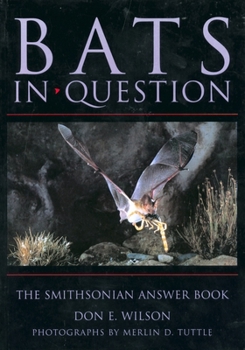Bats in Question: The Smithsonian Answer Book
Select Format
Select Condition 
Book Overview
Book for the Teen Age, New York Public Library. Seeking to dispel the myths associated with these remarkable creatures and arguing for their key role in a balanced ecosystem, the book covers all... This description may be from another edition of this product.
Format:Paperback
Language:English
ISBN:1560987391
ISBN13:9781560987390
Release Date:May 1997
Publisher:Smithsonian Books
Length:192 Pages
Weight:1.65 lbs.
Dimensions:0.5" x 7.0" x 10.0"
Customer Reviews
4 ratings
Answers in full!
Published by Thriftbooks.com User , 14 years ago
For a starter, this is a great book. When starting a search of a new interest one is all questions and this book has the answers to most of them. ~Bruin~
A excellent introduction to the bat family
Published by Thriftbooks.com User , 15 years ago
Don E. Wilson is a Senior Scientist at the Smithsonian's National Museum of Natural History and an expert on bats of the world. This book contains 130 excellent color photos by Merlin Tuttle, and the text is a comprehensive description of bats. It includes a 20 page chart of 925 bat species with the conservation status of each. Wilson is an adviser to Bat Conservation International, which "is devoted to conservation, education, and research initiatives involving bats and the ecosystems they serve. It was founded in 1982, as scientists around the world became concerned that bats essential to the balance of nature and human economies were in alarming decline." I became a member of BCI several years ago, have built several bat houses, and purchased others from BCI. It sometimes takes time for bats to find your houses, and the houses take careful locating to suit the needs of bats (and people). A few hints: - Bats like it hot, so the house needs at least six hours of full sun. - The house should be within 1,200 feet of water. - The house should be at least 15 feet above the ground. - Clear an unobstructed flight path, and make it hard for predators to reach the house. - Remember that bats poop; carefully locate the bat house with that fact in mind. I located my first bat house over our deck, not an ideal location. :( BCI is a great organization if you have any interest in bats; contact info in the first Comment. Other good books on bats include: The Bat House Builder's Handbook, Completely Revised and Updated by Merlin D. Tuttle, founder and guiding light of BCI. The instructions are easy to follow even for a guy who barely passed shop in high school; BCI offers a CD based on the book. America's Neighborhood Bats: Understanding and Learning to Live in Harmony with Them (Revised Edition) by Merlin Tuttle. Bats: Biology, Behavior and Folklore by Glover Morrill Allen. (This book was first published in 1939; some of the scientific information is outdated, but the folklore sections are fascinating.) Little Lost Bat by Sandra Markle and Bat Loves the Night: Read and Wonder by Nicola Davies are wonderful books for kids. Bats in Question is good for readers of all ages, including young children who are fascinated by the great pictures. Wilson's book and Bat Conservation International are two wonderful resources for all nature lovers. Robert C. Ross 2008
The best bat book ever
Published by Thriftbooks.com User , 16 years ago
Why don't baby bats fall off mom bats in flight? Hmmm? The answer to this and all of your other curious musings about the most successful and least understood of the mammals are presented in this latest volume of a Smithsonian series. For children or adults, with excellent close- up photos, this one is sure to foster a growing interest in our flying relatives. About 1/4 of mammal species have winged fingers, big ears and knees turned sideways to facilitate dangling from ceilings, and that doesn't include your weird Uncle Mort! Bats occur on every continent except Antarctica, and in eco-niches as diverse as blood sucking, fruit chewing, fish nipping and insect consumption. Some are excellent mousers. Several types may live for thirty years. As mentioned in my review of THE FORGOTTEN POLLINATORS (Stephen L. Buchmann & Gary Paul Nabhan, Shearwater Books, 1996), the bats include species critical to reproduction for many types of plant, and (along with other pollinator species) many are in steep decline. Here's one little piece of brain candy from this high quality sampler: Baby bats' milk teeth (they have two sequential sets like most other mammals) are hooked and pointy. They lock on to mom's nipple like a Voskod docked to Mir. Look Ma! No hands!
In depth bat education
Published by Thriftbooks.com User , 23 years ago
This is the most informative bat book that I've picked up so far. Lots of great information if you love bats and want to know more about them, or fear bats and are interested in learning to love them. Lots of great photos, but not a picture book at all. Probably too wordy for little kids, but great for adults.




